

Renaissance Period: Timeline, Art & Facts. Causes of the Renaissance - History Crunch - History Articles, Summaries, Biographies, Resources and More. The first main cause of the Renaissance was the increased interaction between different cultures and societies in the time before and during the start of the Renaissance.
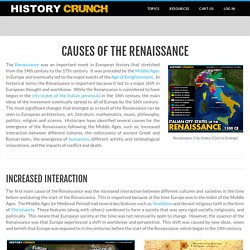
This is important because at the time Europe was in the midst of the Middle Ages. The Middle Ages (or Medieval Period) had several key features such as: feudalism and devout religious faith in the form of Christianity. These features (along with others) combined to form a society that was very rigid socially, religiously, and politically. This means that European society at the time was not necessarily open to change. However, the essence of the Renaissance was that Europe experienced a shift in worldview and perspective.
First, vast trade networks across Europe, Asia and Africa led to increased interaction between different societies which caused not only an exchange of goods, but also an exchange of people, beliefs, ideas and values. What was the impact of renaissance on the people of Europe? Causes of the end of the european medieval period. Crisis of the Late Middle Ages. The crisis of the Late Middle Ages was a series of events in the fourteenth and fifteenth centuries that brought centuries of European stability to a halt.[1] Three major crises led to radical changes in all areas of society: demographic collapse, political instabilities and religious upheavals.[2] A series of disasters, beginning with the Great Famine of 1315–17 and especially the Black Death of 1347-1351, reduced the population perhaps by half or more as the Medieval Warm Period came to a close and the first century of the Little Ice Age began.
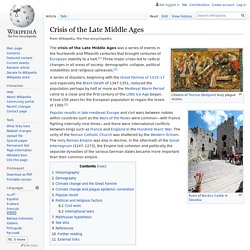
It took 150 years for the European population to regain the levels of 1300.[2] Popular revolts in late-medieval Europe and civil wars between nobles within countries such as the Wars of the Roses were common—with France fighting internally nine times—and there were international conflicts between kings such as France and England in the Hundred Years' War. The Black Death: Turning Point and End of the Middle Ages?
Genesis The Black Death was an epidemic which ravaged Europe between 1347 and 1400.
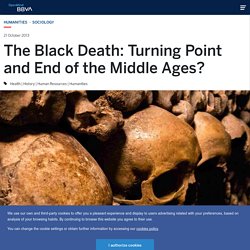
It was a disease spread through contact with animals (zoonosis), basically through fleas and other rat parasites (at that time, rats often coexisted with humans, thus allowing the disease to spread so quickly). In 1347, the arrival of the Black Death to Crimea was already chronicled. The following winter, it was spread by Genovese traders to Constantinople and Italy. Define Middle Ages? What were the causes for the end of the Middle Ages? Schoolworkhelper.
Artists vs TMNT. Epic Rap Battles of History Season 3 Finale. Teenage Mutant Ninja Turtle and the Four Renaissance Artist. Renaissance artists and Teenage Mutant Ninja Turtles. All About Raphael and Donatello. #2 Donatello (1386 - 1466) - mosleyart.com. Viajar en el tiempo: Donatello, Leonardo, Miguel Ángel, Rafael. El Renacimiento es la época que comenzó a finales del siglo XIV y continuó hasta el XVI.
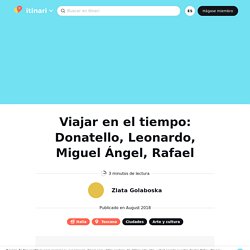
Este es un término que significa desarrollo en cualquier forma. Reborn o Rinascita representa el período más fructífero de la historia del arte y la arquitectura. Vamos a viajar en el tiempo y vamos a Florencia, donde esta vez reflexionaremos sobre los artistas más brillantes del Renacimiento. Todos estos artistas están de alguna manera relacionados con Florencia. Este es un lugar mágico y te mostraré por qué. Donatello Donatello, el mayor de los cuatro, trabajó con extravagancia y exigió libertad artística en momentos en los que la relación entre el mecenas y el artista estaba determinada por reglas estrictas. Leonardo Leonardo fue un arquitecto, inventor, ingeniero, escultor y pintor del Renacimiento italiano.
Miguel Ángel Miguel Ángel Buonarroti fue un escultor, pintor, arquitecto y poeta renacentista italiano, y uno de los artistas más famosos e influyentes en la historia del arte europeo. Teenage Mutant Ninja Turtles. Fictional team of four teenage anthropomorphic turtles, trained in the ancient art of ninjutsu Teenage Mutant Ninja Turtles (often shortened to TMNT or Ninja Turtles) are four fictional teenaged anthropomorphic turtles named after Italian Renaissance artists.
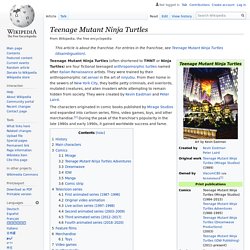
They were trained by their anthropomorphic rat sensei in the art of ninjutsu. From their home in the sewers of New York City, they battle petty criminals, evil overlords, mutated creatures, and alien invaders while attempting to remain hidden from society. They were created by Kevin Eastman and Peter Laird. Raphael, The Young Artist. Raphael, School of Athens. Raphael Sanzio - 6 Interesting Facts. Raphael is one of three master painters during the High Renaissance, alongside Leonardo and Michelangelo.
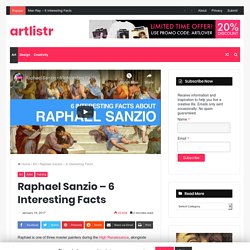
Born Rafaello Sanzio, he left a large body of work, the most important of which being the frescoes found in the Vatican Palace. Aside from being considered the most celebrated artist in the 18th and 19th century, here are the following facts: 1. Raphael learned how to paint from his father. His father ran a painting workshop and was the court painter for the Duke of Urbino, a center for culture around the time of Raphael’s birth.Raphael was orphaned at 11 years-old and he took over his father’s workshop. 2.
Renaissance - Overview - Goodbye-Art Academy. Causes of the Renaissance Video Lecture. World History Online: Ep. 2 - Italian Renaissance Art. World History Online: Ep.1 - The Renaissance. Biography of Michelangelo for Kids: Famous Art for Children - FreeSchool. Leonardo da Vinci for Children: Biography for Kids - FreeSchool. Renaissance Art, Literature, and Architecture. The Renaissance Timeline. All About the Renaissance [Full Program] Renaissance - Overview - Goodbye-Art Academy. Teach with Magic - House: London. For over 100 years scientists have believed that the Medieval Black Death was the same disease as the modern Bubonic Plague.

We're told it was spread by fleas on rats and is now easily controlled with anti-biotics. Today though there are those who doubt the two diseases are the same and how ready we are to deal with this ancient disease if it surfaces again. Your task is to fill in your Investigation Journal as you explore the exhibits. Time: 45 minutes Materials: Video player, printed exhibits, Black Death (2010 DVD) - first 4 minutes Investigation Journal Exhibits (printable) Teach with Magic - Late Middle Ages. Unit Guide Late Middle Ages Notes Activities 1.
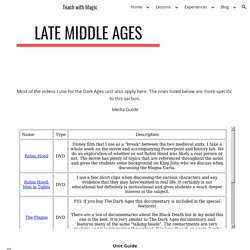
Walkthru: Late Middle Ages 2. 3. Medieval Europe Lesson Plans - Videos & Lessons. History for Kids: How did the Renaissance start? History >> Renaissance for Kids.
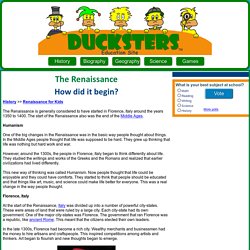
Middle Ages - Definition, Timeline & Facts. People use the phrase “Middle Ages” to describe Europe between the fall of Rome in 476 CE and the beginning of the Renaissance in the 14th century.
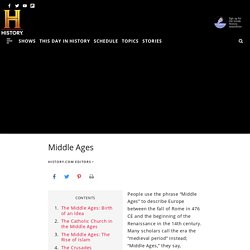
Many scholars call the era the “medieval period” instead; “Middle Ages,” they say, incorrectly implies that the period is an insignificant blip sandwiched between two much more important epochs. The Middle Ages: Birth of an Idea The phrase “Middle Ages” tells us more about the Renaissance that followed it than it does about the era itself. Starting around the 14th century, European thinkers, writers and artists began to look back and celebrate the art and culture of ancient Greece and Rome. Accordingly, they dismissed the period after the fall of Rome as a “Middle” or even “Dark” age in which no scientific accomplishments had been made, no great art produced, no great leaders born. Five Events That Began the Renaissance (Or Ended the Middle Ages) - Well-Trained Mind. The Middle Ages (the favorite historical period of 9 out of 10 young history students!) Is generally thought to occupy the years between the collapse of Rome and the beginning of the Renaissance—between, more or less, 400 and 1600 AD.
Most of us were taught, in history class, that the Middle Ages ended when the Renaissance began. But that’s not quite right. In fact, it’s a little bit like saying, “My childhood ended when I started liking spinach,” or “He stopped being President when he got married.” It’s putting two completely different things side by side, and pretending that they are the same.
For one thing, the Renaissance isn’t a historical period, like the Early Modern period; it’s an intellectual movement. CoolaBoo - Education Site. The word “renaissance” means “rebirth” and it is the time period in Europe that covers the 4th to the 17th centuries. When the fall of the Roman Empire occurred and the Middle Ages began, many of the advancements that had been made during the Roman and Greek empires were lost. This included art, government, music, education, and science. Overview People Culture Daily Life. FREE Renaissance Teaching Resources - mrdowling.com. Blink Activity. 3.1 Las exploraciones portuguesas Desde mediados del siglo XV, el infante portugués Enrique el Navegante impulsó la navegación y los viajes de exploración por las costas africanas. El objetivo de Portugal era acceder al oro de Sudán y comerciar con la India, bordeando la costa de África.
La rivalidad con Castilla en esta zona se solucionó con la firma del Tratado de Alcaçovas (1479). En él, Portugal cedía a Castilla la conquista de Canarias y esta aceptaba que Portugal explorase la costa africana al sur del cabo Bojador. En sucesivas exploraciones por la costa africana, los portugueses ocuparon las islas Madeira, Azores y Cabo Verde; pasaron el cabo Bojador (1431) y llegaron al golfo de Guinea (1460). 3.2 Castilla. El descubrimiento de América se debió a Cristóbal Colón, un marino de posible origen genovés. Tras volver otras tres veces al Nuevo Mundo, murió en 1506 creyendo haber llegado a las Indias, denominación dada entonces a Insulindia, el sur y el sureste de Asia. En Portugal.